Namasia's Green Diamond Elementary School
◎English translation: Peng Hsin-yi
◎Photos by Pao Chung-hui
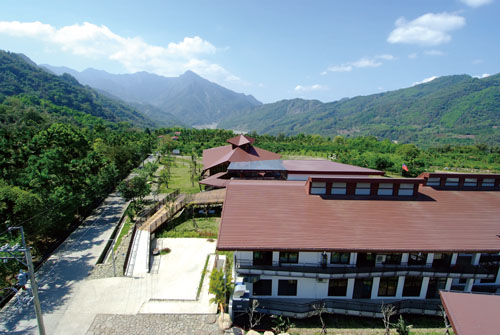 In 2009, Typhoon Morakot completely destroyed Namasia Mincyuan Elementary School. The children feared it would never be rebuilt. Fortunately, the school was relocated in a safe location, 800 meters above sea level. With the generous sponsorship of Delta Electronics Foundation, complete reconstruction of the school was made possible. The foundation appointed architect Kuo Ying-chao to lead the project. In February 2012, the school finally reopened, featuring three buildings, including classrooms, a teachers' dormitory and a library. Constructed from mostly recycled wood and state-of-the-art environmental initiatives, it is a leader in the Green Campus movement and is expected to become Kaohsiung's second construction project (after The World Games 2009 Main Stadium) to obtain the Diamond Level certificate from EEWH.
In 2009, Typhoon Morakot completely destroyed Namasia Mincyuan Elementary School. The children feared it would never be rebuilt. Fortunately, the school was relocated in a safe location, 800 meters above sea level. With the generous sponsorship of Delta Electronics Foundation, complete reconstruction of the school was made possible. The foundation appointed architect Kuo Ying-chao to lead the project. In February 2012, the school finally reopened, featuring three buildings, including classrooms, a teachers' dormitory and a library. Constructed from mostly recycled wood and state-of-the-art environmental initiatives, it is a leader in the Green Campus movement and is expected to become Kaohsiung's second construction project (after The World Games 2009 Main Stadium) to obtain the Diamond Level certificate from EEWH.
There are many initiatives that make the new campus unique. The school stands on two hectares of land which is entirely free of cement, with buildings that incorporate natural elements and resources such as seasonal winds. They have also been designed to be durable in extreme weather and ensure as little human impact as possible. The buildings have been elevated to resemble traditional native dwellings and indigenous architecture. This allows wind and rain to pass freely around and under the building. In the past, people did not take nature into account; however, this green architectural initiative shows respect and consideration towards nature. Electricity is generated by solar panels that have been installed on the roof of the classroom building, as well as six windmills that fully utilize renewable energy.
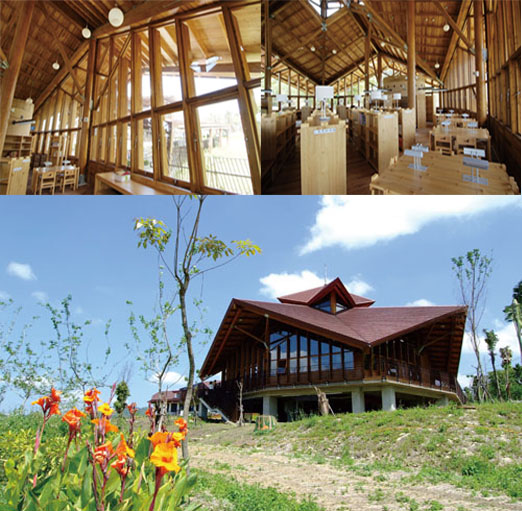 Architect Kuo Ying-chao is renowned for his award-winning design, Pavilion of Dreams at Taipei's International Flora Exposition. On February 8, 2012 the new campus was officially inaugurated. Many children showed their appreciation by telling Kuo Ying-chao, "I love you, Mr. Architect" and he felt there was no greater praise for a job well done. The school is located very high up in the mountains where the roads were washed away during Typhoon Morakot. Every time there is a heavy rainstorm, the roads always get washed out; however, the residents are not daunted by these conditions. Guo Ying-chao was impressed by the locals' spirit of perseverance and steadfast spirit to rebuild. One parent told Kuo Ying-chao that they hadn't wanted the school to restore the past, but to lead them into the future. Therefore, the project was designed to give the children a great future.
Architect Kuo Ying-chao is renowned for his award-winning design, Pavilion of Dreams at Taipei's International Flora Exposition. On February 8, 2012 the new campus was officially inaugurated. Many children showed their appreciation by telling Kuo Ying-chao, "I love you, Mr. Architect" and he felt there was no greater praise for a job well done. The school is located very high up in the mountains where the roads were washed away during Typhoon Morakot. Every time there is a heavy rainstorm, the roads always get washed out; however, the residents are not daunted by these conditions. Guo Ying-chao was impressed by the locals' spirit of perseverance and steadfast spirit to rebuild. One parent told Kuo Ying-chao that they hadn't wanted the school to restore the past, but to lead them into the future. Therefore, the project was designed to give the children a great future.
The charming little schoolhouse in the mountains
Kuo Ying-chao is from Taipei, with most of his life having been spent in big cities. Therefore, he spent a great deal of time going through documents and historical records, so the school would reflect the traditional culture and architecture of Tsou and Bunun tribes. He also worked to preserve the traditions and ideology of indigenous living spaces.
Kuo Ying-chao also consulted the children and asked them to write down what they believed a school should be. He said the children had some really creative ideas; one even asked for a rollercoaster. They did however all convey a unanimous message: to create a school that would be fun! Mr. Kuo took this into account and designed the classroom building to resemble a Bunun grand-house. He hoped the school would give the children the feeling they were just walking through rooms in their own homes. It was designed to give the children a comfortable place to study and play.
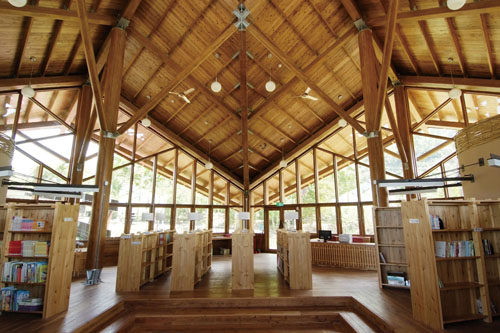 Considering severe winters in the mountains, Kuo Ying-chao designed the building to have classrooms facing each other with the corridors running down the middle. This also resembles the traditional living space of the Bunun family. The classrooms and corridors are also separated by dividers instead of walls. Therefore in an emergency the entire building can be converted into a big open space and serve as a shelter for local residents. The buildings' exterior exhibits a dynamic, fluid design; however, Kuo Yi-chao believes the inside is even better, especially the roof in the classroom building. He has added several traditional tribal totems and used resources made from environmental and recycled materials. This is exemplified in items such as space dividers that are made of compressed recycled paper and bamboo arrows made from a plant found in abundance in surrounding areas. Venting windows are placed in strategic positions around the classrooms, so the wind can pass through and under the building. An electricity monitoring system ha
Considering severe winters in the mountains, Kuo Ying-chao designed the building to have classrooms facing each other with the corridors running down the middle. This also resembles the traditional living space of the Bunun family. The classrooms and corridors are also separated by dividers instead of walls. Therefore in an emergency the entire building can be converted into a big open space and serve as a shelter for local residents. The buildings' exterior exhibits a dynamic, fluid design; however, Kuo Yi-chao believes the inside is even better, especially the roof in the classroom building. He has added several traditional tribal totems and used resources made from environmental and recycled materials. This is exemplified in items such as space dividers that are made of compressed recycled paper and bamboo arrows made from a plant found in abundance in surrounding areas. Venting windows are placed in strategic positions around the classrooms, so the wind can pass through and under the building. An electricity monitoring system ha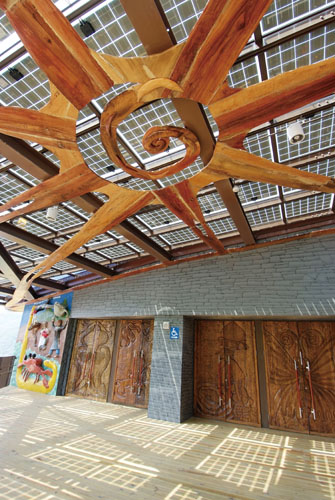 s also been installed in the building, ensuring energy efficiency. With solar panels and windmills, 50% of all the schools energy is produced sustainably.
s also been installed in the building, ensuring energy efficiency. With solar panels and windmills, 50% of all the schools energy is produced sustainably.
The teachers' dormitory is another fine example of green architectural design. Before construction began, principle Wu Ting-yu explained his first priority was to provide the teachers with a safe and comfortable living environment, so they would be able to better focus on their teaching. The big windows and corridor were constructed from drift wood and allows airflow to cool the rooms naturally, abolishing the need for air conditioning. The dormitory contains twenty-four single occupancy rooms. Each room has its own solar powered water heater. Therefore in emergency situations, the system can provide hot water for three-hundred people, for six days.
The library was built to resemble the architecture of male tribal culture. Traditionally young males attended to the elders, where they would pass knowledge and wisdom down to the younger generation. Mr. Kuo wanted the library to reflect a place where knowledge can be found, learned and passed on. The library is constructed from wood and resembles the shape of a datura flower, native flora indigenous to the area. The flower can be seen blooming along the road and pathways leading to the school. In additional, an eco-pond was created outside of the Library and is surrounded by plants of different heights and sizes. The water and the plants are not just for the purpose of landscaping, but also serve the purpose of temperature regulation and land preservation.
When entering the library, visitors must take off their shoes and change into indoor slippers. With a shoe rack that was full of children's shoes, it was clear young, inquisitive minds were hard at work. The library also features venting windows, naturally regulating the room's temperature. The reading room also has a high ceiling with glass panels that maximize the use of natural sunlight and excellent views. The reading desks, chairs and lamps are also customized for children, making reading a more enjoyable experience. Everyone involved in the project, such as principle Wu, architect Kuo, the Delta foundation and residents of Namasia regard the library to be the best gift for the seventy-five children's future.
These ultra-advanced green buildings have been constructed 800 meters above sea level; the entire project took approximately fourteen months and was entirely documented by National Geographic. On April 22nd, the documentary made its debut in Taiwan. The documentary will also be aired in 35 other countries. This illustrates how a small mountain village in Kaohsiung could find a balance between human civilization and the future.
海拔800公尺的鑽石級綠建築
那瑪夏民權國小
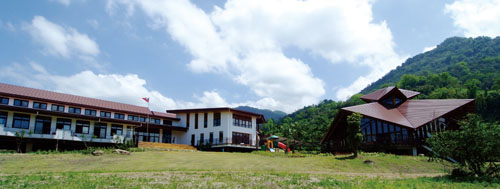 ◎文/侯雅婷
◎文/侯雅婷
◎攝影/鮑忠暉
2012年2月重建後的那瑪夏區民權國小落成啟用,美麗的校舍和曼陀羅花造形的木造圖書館豔驚各界,被譽為綠色校園的新典範,校舍可望成為高雄市繼世運主場館之後,第二棟取得鑽石級認證的綠建築。
民權國小佔地兩公頃的校舍地上水泥覆蓋率是零!校內三棟建築物包括教學棟校舍、教師宿舍及圖書館都在建造前測量過風向,且均採用高腳屋建築設計結構,因此建築物不需順應地形,不會因施工而破壞大自然環境,屬於大自然的土地讓風恣意通過,下雨時,水得以滲透到地下。在這,綠能建築代表人類對大自然的謙卑、尊重和友善共存,僅僅在教學棟校舍建置太陽能光電板 ,以及校園一隅矗立著六座風力發電機,妥善運用大自然的能源。
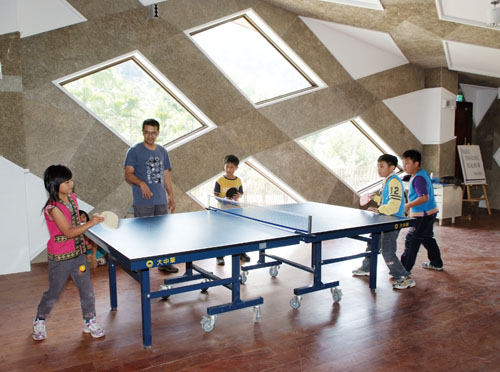 民權國小原址於2009年莫拉克颱風肆虐下毀壞殆盡,小朋友們一度擔心沒有學校了!由台達電文教基金會協助重建,並聘請負責台北花博新生三館的郭英釗建築師操刀,2月8日落成啟用當日 ,小朋友對建築師郭英釗說:「建築師我愛你!」孩子們對新校舍的喜愛溢於言表。
民權國小原址於2009年莫拉克颱風肆虐下毀壞殆盡,小朋友們一度擔心沒有學校了!由台達電文教基金會協助重建,並聘請負責台北花博新生三館的郭英釗建築師操刀,2月8日落成啟用當日 ,小朋友對建築師郭英釗說:「建築師我愛你!」孩子們對新校舍的喜愛溢於言表。
郭英釗談起重建的過程,通往學校的路遇到颱風來襲或豪雨而中斷,路經常斷了又修,修好了又斷,但那瑪夏當地居民展現強烈的韌性和意願要留在當地發展,讓郭英釗印象深刻,郭英釗特別提起,有位家長曾表示,他們要重建的是學校的未來而不是過去,這番談話讓他思索,機會應該往未來走,因此整個設計案是朝學校未來展望而設計。
最迷人的山裡學校
為了設計這間位於山裏的學校,遠在台北、住在都市的郭英釗透過文獻和資料來研究布農族和鄒族的文化、傳統建築與空間,正因為教育有其獨特之處,為了設計出最貼近小朋友需求的理想學校,郭英釗請小朋友寫下心目中理想的學校,他笑說,小朋友天馬行空的願望中,有的甚至希望學校能有雲霄飛車,但解讀每一則留言背後的訊息,小朋友們的共同願望是,希望學校能夠很好玩!
教學棟校舍以布農族大屋的空間概念為設計主軸,每間教室就如同是部落般,讓孩子感覺,上學彷彿是離開家又回到另一個家一般,希望孩子在學校盡興的學習和玩耍,也體貼地考量山裏的學校在冬天時,戶外的溫度可是會讓小朋友冷得打哆嗦,因此一改平地校舍走廊在戶外的設計,民權國小將走廊放進室內,走廊的兩側是一間間的教室,而民權國小校舍同時兼具防災避難中心的功能,每間教室與走廊的隔間門,一拉開就是寬敞的空間,遇有緊急狀況時,提供當地居民使用。
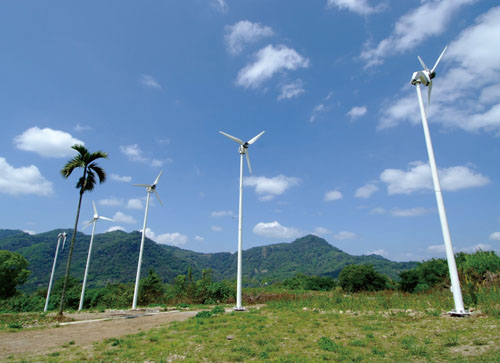 郭英釗叮嚀著室內比戶外漂亮多了,記得抬頭看看教學棟天花板的圖騰。綠建築廣泛地應用於教學棟建築的許多方面,比如廢紙壓縮成的隔板建材的牆面,也使用當地所產的箭竹為建材,教室也裝設通風口,讓高腳屋的風能從地下進到教室內。而教學棟設有能源監控系統 ,校內各處用電情況一目了然,靠著蒐集太陽能和風力能源,民權國小能源替代率達50%。
郭英釗叮嚀著室內比戶外漂亮多了,記得抬頭看看教學棟天花板的圖騰。綠建築廣泛地應用於教學棟建築的許多方面,比如廢紙壓縮成的隔板建材的牆面,也使用當地所產的箭竹為建材,教室也裝設通風口,讓高腳屋的風能從地下進到教室內。而教學棟設有能源監控系統 ,校內各處用電情況一目了然,靠著蒐集太陽能和風力能源,民權國小能源替代率達50%。
教師宿舍是設計的另一個重點,吳庭育校長表示,要讓前來教學的老師住得安心,才能無顧慮地專心教學,推開走廊旁以漂流木打造的大窗戶,宿舍走道立刻自然通風,無比涼快,校舍提供24間單人房,每間均設有太陽能熱水器,在緊急時可供應300人6天的用水量。
到民權國小沿路上,一旁盛開著曼陀羅花,於是乎,郭英釗以曼陀羅花造型,打造木造圖書館外觀,而圖書館的建築形式則取自原住民部落的男子會所,年長的老獵人會在男子會所傳授年輕獵人經驗與智慧,象徵智慧與傳承的深刻意涵巧妙地轉化為今日的圖書館。圖書館的戶外,築起小型生態池,以高矮不一的植栽等不同的方法調節溫度和水土保持。
 圖書館處處洋溢著今天是讀書天的氣氛,進入圖書館要先換上拖鞋,但鞋架上只有小朋友的超小號鞋,宣告著這是屬於小朋友的天地。打開窗戶,導入自然風,室內挑高的空間,透過玻璃的運用,日照充足、採光明亮,放眼望去,又是另一番風景。還有專為小朋友打造的桌椅和檯燈,在這飽覽群書是件快樂的事,迷人的學習空間,是大人們獻給全校75位小朋友無限可能的未來!
圖書館處處洋溢著今天是讀書天的氣氛,進入圖書館要先換上拖鞋,但鞋架上只有小朋友的超小號鞋,宣告著這是屬於小朋友的天地。打開窗戶,導入自然風,室內挑高的空間,透過玻璃的運用,日照充足、採光明亮,放眼望去,又是另一番風景。還有專為小朋友打造的桌椅和檯燈,在這飽覽群書是件快樂的事,迷人的學習空間,是大人們獻給全校75位小朋友無限可能的未來!
在海拔800公尺的那瑪夏區民權國小築起了走在時代最前端的綠能建築,國家地理頻道團隊耗時1年2個月完整紀錄施工過程,民權國小紀錄片於4月22日首播,隨著影片的播出,全球共有35個國家一同領略台灣高雄的那瑪夏民權國小,於大自然與建築之間取得平衡的代表作。